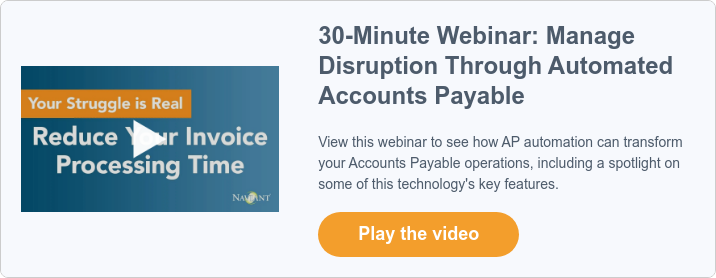Your ERP can’t solve your AP challenges alone. Even more, relying solely on an ERP to manage your organization can be risky.
ERPs are vital tools to simplify business processes and record information. However, they can’t turn your AP department into a profit center on their own. A recent report from Levvel Research ranked manual routing of invoices for approval and manual data entry as the top two biggest challenges within the AP process. Given that ERPs aren’t designed to cover invoice capture, approval, matching, or error and duplication detection, it’s clear that they alone can’t help AP departments thrive. As a result, chances are, you’re doing more manual work than necessary, which slows processes down dramatically.
For this reason, more organizations are integrating AP automation with their ERPs to take over the capture, validation, routing, and management of AP data across their systems. And the benefits that this dynamic duo can produce are significant.
5 Ways AP Automation Maximizes ERPs
1. Reduced Operational Costs
When you integrate AP automation with your ERP system, you can reduce the need to add ERP seats for AP automation. This opportunity alone can save organizations tens of thousands of dollars in overhead. Additionally, you can lower your spending on expensive ERP licenses and end-user training.
AP automation can also help reduce costs by automating and accelerating the entire AP process from start to finish:
• AP automation’s advanced, highly accurate intelligent capture means you can eliminate paper, cutting the costs associated with printing, storing, and shipping paper.
• AP automation digitizes and validates invoices against the data within your ERP, eliminating the need for manual data entry.
• When an invoice is approved, all important associated data is automatically uploaded to your ERP system.
• In the case of an exception, it electronically routes the invoice to the appropriate approver based on rules you define.
With all these manual tasks out of the way, your staff can redirect their time to more value-added activities that affect the bottom line.
2. Better Visibility
AP departments relying solely on ERPs often struggle with visibility. As a result, staff lacks access to the information they need to make decisions and respond to inquiries. But with AP automation on board, you can easily retrieve invoices, vendor contracts, and receipts directly from your ERP system. It also grants you visibility and insights into each stage of the AP process, from receipt to validation, approval, and posting. You even gain valuable visibility into cash flows.
You can use interactive reporting dashboards to get real-time visibility into the status of invoice approval and exceptions. This allows managers to approve completed tasks, identify process bottlenecks, reassign tasks, and discover areas that need improvement. Plus, all this information is easily accessible via mobile devices, web browser, or Microsoft SharePoint, so you can ensure that your AP processes are performing at their best, anywhere, anytime. Integrating AP automation with your ERP also offers an end-to-end audit trail for AP processes, allowing full visibility every step of the way.
3. Greater Accuracy
If you’re relying on an ERP powered by manual, paper-based processes, chances are, you’re facing a high volume of incomplete or incorrect data. And whenever an invoice contains such mistakes, the reconciliation process is likewise manual. AP automation’s advanced capture capabilities allow the software to capture invoice data, regardless of language, currency, or format. And it does so with impeccable accuracy, eliminating time-consuming manual steps while reducing the likelihood of errors. No more human error.
4. Save Time with Faster Cycles
AP Automation can help AP staff keep up with rising demand. AP departments are facing unusually high volumes of invoices today, with no sign of slowing down. As of January 2022, more than 75% of AP teams report processing more invoices in the most recent quarter, up from 66% in the prior two quarters. Additionally, half say they are working longer hours to make up for the additional work. The rest report adding staff or automation to help make ends meet.
AP automation accurately captures all invoice data as soon as it’s available, regardless of where it’s received, and integrates it with your ERP system. As a result, you can achieve true end-to-end automation of your entire AP process, enabling faster cycle times. This technology enables managers and buyers to approve, reject, or research invoices as needed using their computers, laptops, tablets, or smartphones. You can also rely on it to strictly enforce control policies and ensure invoices reach appropriate staff every time with its configurable workflow rules. Integrating AP automation with your ERP systems also enables you to cross-reference invoice data to ERP and master supplier data. This process serves to dramatically reduce the errors that used to slow down your cycle times.
5. Enhanced Flexibility and Scalability
When you integrate your ERP system with an AP automation platform, you gain access to greater workflow flexibility than what your ERP alone can offer. Workflow tools offered by ERP systems can come with a significant amount of time, cost, and risk. AP automation, on the other hand, requires only a fraction of these costs. They’re also easy to use. You can create workflows to fill even the most complex needs you may have. You can readjust processes as your needs change, like increased volume or suppliers, making it highly scalable. And without involving IT.
AP automation also allows you to extend approval rights to non-ERP users without the need to provide direct ERP access. Plus, if you change or upgrade your ERP system, your AP automation platform remains completely intact. Finally, you can support and connect multiple ERP systems with a single AP automation platform. This benefit is especially appealing to the near 40% of businesses that operate multiple ERP applications in one or more locations.
Put Your AP Automation Project on the Fast Track
We know how intimidating it can be to start a new project, including an AP automation-ERP integration. That’s why we’re now offering the Naviant AP Accelerator, a ready-to-use automation solution. This solution combines ABBYY FlexiCapture for Invoices and OnBase document processing.
These two technologies come together to deliver some amazing outcomes for our clients. For example, Clay Lacy Aviation implemented these solutions to enjoy results including:
• Going 100% paperless and eliminating 25,000 paper expense reports annually
• Reducing their invoice processing error rate from 10% down to .02%
• Boosting its efficiency by automating 95% of invoice approvals
Maximize Your ERP Investment with AP Automation
In today’s increasingly regulated and fast-paced business environment, organizations can’t afford to face the challenges of poorly integrated payables and ERP systems. An AP automation platform can enhance your ERP system by excelling in many of the areas your ERP struggles.








